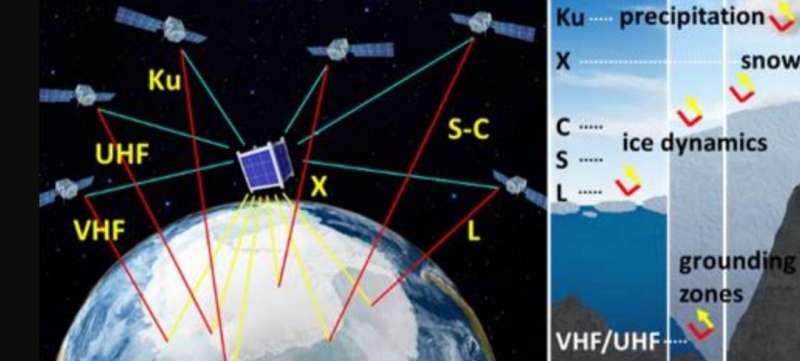This article has been reviewed according to Science X's editorial process and policies. Editors have highlighted the following attributes while ensuring the content's credibility:
fact-checked
trusted source
proofread
How a single atomic sensor can help track Earth's glaciers

Earth observations are one of the most essential functions of our current fleet of satellites. Typically, each satellite specializes in one kind of remote sensing—monitoring ocean levels, for example, or watching clouds develop and move. That is primarily due to the constraints of their sensors—particularly the radar.
However, a new kind of sensor undergoing development could change the game in remote Earth sensing.
That new sensor technology is known as a Rydberg sensor, and it uses quantum theory to detect a broad band of radar signals all at once. Darmindra Arumugam of NASA's Jet Propulsion Laboratory, who specializes in remote sensing and has worked with the technology for years, will be working on the development.
So why are Rydberg sensors so special?
In a typical remote sensing application, a sensor is launched on a satellite that is very good at detecting a particular frequency of light. In radar terms, these are broken up into several different "bands," each covering anywhere from a few megahertz to a few gigahertz. Some are more familiar than others, such as UHF (ultra-high frequency—300–1,000 MHz), but some are more esoteric, such as the Ku band from 12–18 GHz.
Each of these bands is good at monitoring one particular system back on Earth. For example, NASA uses the VHF (30–300 MHz) to study Earth's tomography and the UHF band to study snow and rainfall.
However, each of these frequencies would require its own specially designed antenna to detect, so any system that would attempt to have detection capabilities over a wide range of frequencies, and thereby be monitoring a wide range of different systems, would get more and more expensive as additional bands were added to the system.
That's where Rydberg sensors come in. They are a novel type of sensor that uses the quantum state of a single atom to detect a broad band of different electromagnetic waves. For example, a single Rydberg sensor could detect signals from the HF band all the way up through the Ka-band at the faster end of the radar spectrum. This would allow a satellite with a single sensor to monitor all the different systems that radar can detect remotely.
Explaining the functioning of a Rydberg sensor requires a relatively complete understanding of quantum mechanics. Rydberg sensors are named after a quantum state known as the Rydberg state, which is extraordinarily sensitive to its environment.
To get to the Rydberg state, engineers have to zap a single atom of Rubidium or Cesium with a laser to make it grow to an extraordinarily large state—almost to the size of a bacteria. They then optically monitor changes in the atom, which is affected by signals in the radar bands previously mentioned.
The supporting optical system then analyzes the changes in the atom and can correlate those changes to changes in the signal at a particular frequency band.
Several proofs of concepts have already been shown, such as those provided by the National Institutes of Standards and Technology. But they have yet to be applied to space—and that is where Dr. Arumugam's research comes in. His project is to develop a Rydberg sensor that can be launched on a satellite and detect a broad band of radar signals, including those that monitor the cryosphere, where ice and snow are present on land.
With a single Rydberg sensor, Dr. Arumugam hopes to capture all the data for a complete picture of how Earth's glaciers, snow melt, and ice pack change over time.
That is still a long way off, as rides into space aren't well known for being gentle, and so far, Rydberg sensors have only ever been shown to work in a lab. But, given that the technology is only ten years old, there is much potential room for improvement.
As Dr. Arumugam says at the end of his proposal write-up, this technology "[has great] potential to generate interest within NASA, the public, and industry… " If it works how theorists expect it to, he will be proven right.
Provided by Universe Today



















